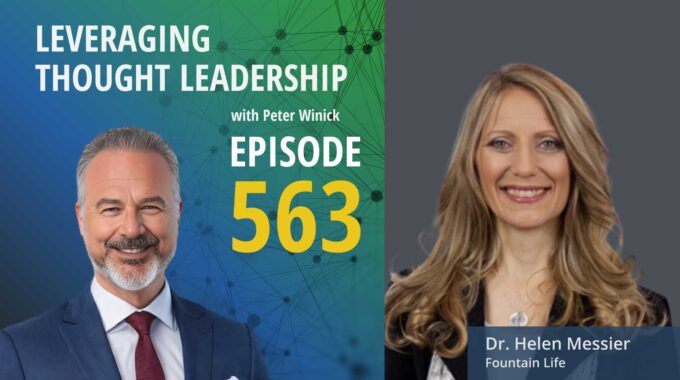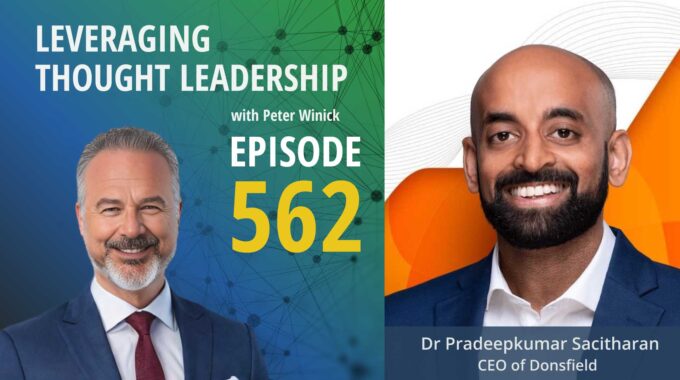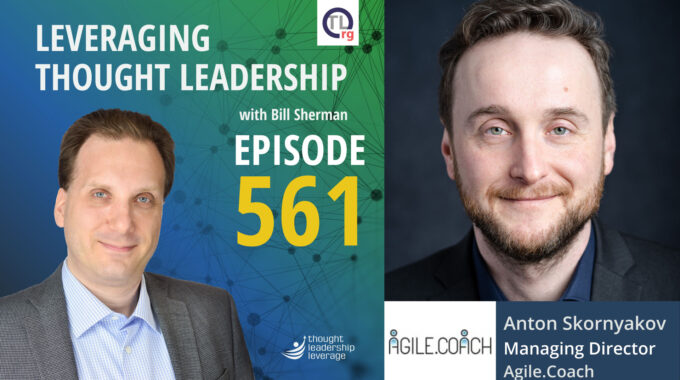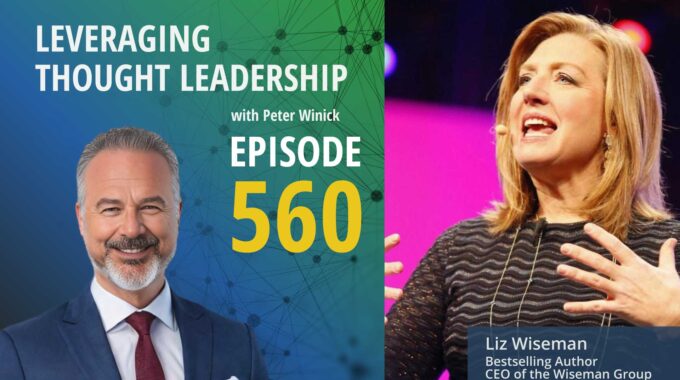Strategies for Shaping the Future of Healthcare A conversation with Dr. Helen Messier about what…
CEO Branding | Raoul Davis
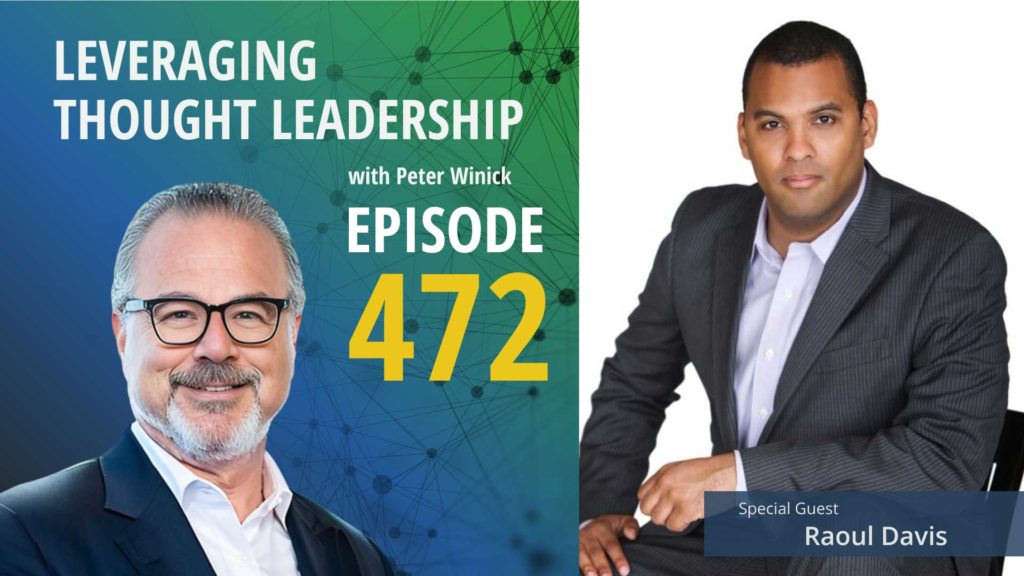
Building thought leadership for CEOs
An interview with Raoul Davis about building a personal brand using thought leadership.
It is important for CEOs to have a personal brand that supports their organizational brand.
That\s why smart CEOs build their personal thought leadership early on, and maintain it throughout their careers.
Today we are joined by Raoul Davis, the Founder, and CEO of Ascendant Group Branding one of the first and most integrated CEO branding firms. In addition Raoul is the author of Firestarters: How Innovators, Instigators, and Initiators Can Inspire You to Ignite Your Own Life which is based on interviews with entrepreneurs and leaders in many walks of life, this self-help book gives readers the tools for finding success in their careers, businesses, organizations, and private lives.
Raoul starts by laying out the various types of branding you can build, such as personal and organizational. We learn how a CEO with a strong personal brand can create a sense of connection and commonality with customers, making them trust and want to interact with the company as an extension of the CEO.
Building such a strong trusted brand can be accomplished best with thought leadership, which can be institutionalized across the organization as a way of demonstrating leadership in an organic way that is more powerful than traditional marketing. Raoul explains how thought leadership can evergreen lasting far after you’ve finished paying for traditional marketing.
It’s never too early to start building your thought leadership and your brand. Raoul shares advice for those early in their career on where they can start, such as by finding a niche within a larger area of expertise to drill down on and become an expert in. By sharing your thoughts and ideas on the subject on social and within your organization you can become the go-to person for that subject, which can open new doors of opportunity.
This conversation provides excellent advice for starting or sharpening a personal and organizational brand that is useful to professionals at any stage of their career.
Three Key Takeaways:
- It is important for a CEO to have a brand that supports the brand of their organization.
- Talk in terms of the interests of the audience, this allows you to communicate in a way that will provide value to them.
- There is an authenticity to thought leadership when you are sharing what you know simply so others can benefit from it.
If you need a strategy to bring your thought leadership to market, Thought Leadership Leverage can assist you! Contact us for more information. In addition, we can help you implement marketing, research, and sales. Let us help you so you can devote yourself to what you do best.

Transcript
Peter Winick And welcome, welcome welcomes Peter Winick. I’m the founder and CEO at Thought Leadership Leverage and you’re joining us on the podcast today, which is Leveraging Thought Leadership. And today my guest is Raoul Davis. He is the founder and CEO ascendant group branding. And we’re going have some fun today because he does a lot of work with PR, corporate branding, CEO branding, etc.. So there’s a little bit of an overlap in terms of some of the things that we do. But I think more importantly, there’s an alignment around a lot of our thinking, based on a call we had a couple of weeks ago. So welcome aboard, Raoul. How are you doing?
Raoul Davis I’m great. Glad to be on.
Peter Winick So give me a sense of what, you know, when we go back to the personal branding movement. Right. And then building on that, we’ve got your corporate brand and the importance of all those things there. Touch on that as it connects to and relates to thought leadership today, because I think ultimately that’s where it’s pointing to.
Raoul Davis Yeah, I mean, so I think where this idea of kind of CEO and executive branding stems from is that we saw all these marketplace examples where you had CEOs who, based on how they communicated it, made you kind of like the company a bit more. Right. It makes you want to kind of really connect with that, Right. I mean, what was your.
Peter Winick Or, or not .
Raoul Davis Or not.
Peter Winick More. Yeah.
Raoul Davis So what was the initial advertising market for Tesla? It was Elon Musk. Right. And that’s a very extreme example. But more kind of practical nature of that is that when you have a CEO who is communicating passionately and you can tell they believe it makes you pay a little bit more attention to that company because you’re saying to yourself, well, he’s bought in, maybe there’s something there. Right. And so you can carry that through from an expertise perspective where they’re talking the substance of the business and then that is helping the marketplace understand, well, what’s that? What’s different about this perspective? And then how could that tie back to the company? I think that’s where it all stems from.
Peter Winick So let me give you as you’re talking, there are two examples that came to my mind. One was, was Benioff and Salesforce, right? Probably more so a few years ago than maybe today, as much as is less active as a CEO or whatever. And the other was Schulze from Starbucks, which is more product. Right. So give me maybe compare and contrast or.
Raoul Davis Yeah. So I think the difference is that with Salesforce, this is obviously B2B, right? And so you are like an entrepreneur is communicating to entrepreneurs many times or is talking to high level business leaders at major companies. And the common ground is there’s so many tools you can choose from in terms of like CRM, right? So in a sea of hundreds and many of them are good, what’s going to differentiate years? I kind of think of it like NASCAR. All the cars are high performing cruise. They all have millions or hundreds of thousands of dollars put into them. What what’s the difference with every car but driver? Right. Well, and so if you’re able to feel that connection and see that difference, maybe you say to yourself, okay, that one stands out to me a little bit more, so let me give them a shot. Right. So I think that’s where it matters from that perspective. Then on Starbucks, I think, you know, people like Starbucks and then to know that the CEO is someone that you feel cares, you see his vision behind him, it makes you that much more connected to the brand versus Southwest, Right? Everyone loves Southwest. And then there is this major travel issue over the winter of 2022, and all of a sudden the CEO fails to communicate proactively, ends up being very kind of reactive and the federal government has to step in and then they start talking about all the great things they’re going to do for consumers. Yeah. After the federal government forcing you to. So that’s a big hit and that’s a brand I could have led and chose not to. And that’s going to have some repercussions on our business.
Peter Winick Yeah. And I also think that that specific instance was a violation of what we had come to expect from Southwest. Like everybody, it’s airlines. There’s whether things happen, it’s, you know, whatever, whatever, whatever. But that was just a debacle. Anyway, I want to sort of move this slightly differently. So if we agree that there’s incredible importance around a CEO having their brand that supports the brand, that they are the shepherd of. Right. And like you said, it’s the passion you could you can understand some of, you know, Howard Schultz, a love for coffee and B, some of his passions around health care for work like that and things sort of embedded in that, that you’re like, you know, I kind of feel I feel better about that brand than maybe Dunkin Donuts or something.
Raoul Davis That’s right. Yeah.
Peter Winick That great coffee. And maybe it’s a little bit cheaper or whatever, but do they stand for anything? I don’t know. Doesn’t appear to it on my end. But think about it for the other 99.99% of the world. That’s not a CEO. What is it that I should be thinking about as a young professional, as a high potential executive, as an emerging leader, etc.? As a senior leader? How do I start to and when do I start to build my thought leadership that allows people to get an understanding of who I am and what I’m about? Before we have a meeting, before we get on a call.
Raoul Davis Yeah. And Peter, I’m sure you have this conversation all the time with your clients. Is that what leadership should be institutionalized within any organization? Because it gives you this ability to demonstrate leadership in an organic way. And it’s so much more powerful than advertising because it doesn’t stop the moment that you stop paying for the ads, Right? It lasts forever. People appreciate seeing something that was organically one that has earned its way in terms of whether it’s a TV interview, an article, or even your blog. Like if you were showing thought that I can resonate with, it makes me feel more connected to you. Right. And that’s why it’s valuable before a meeting. Because if I’m already resonating with something you say or already feel like you’re an expert, you’ve demonstrated that expertise, you’ve already improved your positioning versus the next ten people I might be meeting with.
Peter Winick Well, and you know, I love the way you’re sort of framing that. I think there’s another argument to be made on top of that, which is cost effective. Right. Think about, yes, the cost of paid media. And as costs go up, credibility on the receiver’s end goes down like does anybody Super Bowl commercial. Here’s you know whatever before it’ll spend $100 million to come be there pickup truck. Great. Do I believe it? More or less, because I saw a slick commercial. Probably not. Now, if there’s somebody at Ford on the electric vehicle side talking about the environment and the, you know, all that sort of stuff that I’m following, that’s maybe an engineer, I’m probably more tuned in to what that person has to say and why they’re saying and what they believe and what they see. Then a celebrity driving around in a pickup truck telling me how cool I’ll look if I buy it.
Raoul Davis Yes.
Peter Winick So if you and I agree, which it appears that we do, that it’s important. How and when do you start it as an exact because you’re starting at the top down mostly in your world. Right. Working with CEOs, helping them, etc.. And I’m just sort of for the sake of.
Raoul Davis But I think a young professional can start, right? It’s like, what are you planning to be an expert in? Take some small piece of that right. And begin to be the best in the world for that one small aspect of that. Right. So what is the subcategory that you can begin to own? Build your expertise around, articulate that expertise in the world, and then have that carry through on your LinkedIn, on your other social platforms, You know, hopefully media, right? But it can always be done at some level. And if you are in your early twenties and you start doing that, you are on a natural pathway. By the time you get four or five years in your career to be so far ahead of all of your peers, right? And you just take the trajectory back.
Peter Winick Yeah, I like, you know, he said to get it out in the world and be best in class. And I would say if your earlier in your career in the world might just mean internal in your organization by inside your company or gal that everybody goes to better understand X, whatever X might be. And you could broadcast that internally, build up a rapport, build up a relationship, etc. Guess what? That’s going to put rocket boosters on your career trajectory. If you suddenly have access to SVP, managing directors, whatever stuff that a you know, early career person typically wouldn’t as an equal, as a peer, someone they trust and admire.
Peter Winick If you’re enjoying this episode of Thought Leadership Leverage, please make sure to subscribe. If you’d like to help spread the word about our podcast, please leave a five star review at ratethispodcast.com/ltl and share it with your friends. We’re available on Apple Podcasts and on all major listening apps as well as at Thought Leadership Leverage dot com forward slash podcast.
Raoul Davis And there’s another tie in with that. Right. By, by, mastering it for yourself. It can put you in a position where you can potentially be sponsored or ask for a mentor higher in the organization and then start doing it for them. Right. And then that will really help your career as well.
Peter Winick I think, you know, one of the things I find is, you know, one of the benefits of doing something like this, right? So we’ve been doing this podcast for over five years 450 episodes or whatever. So there’s sort of there’s lots of benefits. But to that we don’t talk about a lot or one is relationships, right? So everybody that’s on the podcast I have a call with before and I’ve made some wonderful relationships, both professional personal resources in different spaces that I didn’t know. And then the other is access. Like you and I might not be talking if it weren’t for my having this this little platform here. So I think that’s another piece to that. When you’re creating thought leadership, when you’re developing an article, video, podcast, whatever, you have access and you can use that access to strategically and deliberately build relationships that you might not be able to without that.
Raoul Davis Yeah. So, you know, we just worked on a book release for Joe Hart CEO Dale Carnegie, and one of the Dale Carnegie’s principles is talk in terms of the other person’s interests. Right? And so that in many ways is what all relationship building and even thought leadership is about is like how you’re communicating. Is is this going to provide value for the reader. Right. And that’s why thought leadership is a more effective avenue than any other kind of corporate PR strategy there is, because these media outlets are tired of just getting corporate press releases that say the same thing and me going to virtual trash, or we’ll send you to the advertising department and ask you to spend for pay for it.
Peter Winick Or go to the other end of that is and, you know, people ask me this all the time, and I think it’s almost a silly question, sort of, well, what about influencer marketing? I’m like, okay, well, let’s talk about that. By very definition, they’re trying to influence you to do something that you probably didn’t want to do, wasn’t going to do, etc.. Whether that’s, you know, buy this bottle of perfume or click on this or whatever, I think there’s something a little bit more authentic around thought leadership, like, hey, I just want to share what I know, what I’m passionate, what I you know, what I’m about so that you can benefit from it. Yeah. If there’s stuff that we can do in business, then that’s all. That’s all great. But it’s not as contrived as some, you know here. You know, I’m an Instagram influencer peddling a brandy or something.
Raoul Davis Yes. And no offense to influencers, but your point is.
Peter Winick Maybe.
Raoul Davis 100% right.
Peter Winick Is about watching, listening. Sorry. Like, whatever. They’ll get over it. Just look at their bank accounts versus mine and Bill and all.
Raoul Davis Live. Yes.
Peter Winick Live. Yeah. I’m not starting a telethon for them, but yeah, but I think that’s the whole point is that there are yes, some of the objectives of leadership can be to open people’s minds, to change their thinking, to get them to embrace a different way. But it’s not. And I have 17 seconds to do it on instant. Right. Like it’s well.
Raoul Davis It’s that it’s that I don’t know if you ever saw a movie Inception, but the idea is that you can’t tell someone what to think. They have to have a thought be inspired, right? So thought leadership allows that space for inspiration. Yes, I’m reading what someone else is saying, but I’m choosing to read it. It’s not shoved down my throat and then there can be something in there. But I can adapt and take as my own and benefit me. Right. So that’s why people like Fault Leadership, because they’re looking for inspiration.
Peter Winick Yeah. So let me ask you this. Oftentimes in many companies, the sort of culture is let’s not do anything to rattle anybody. Let’s just keep everybody calm, cool and collective. Let’s not stand out, let’s not be controversial, whatever, whatever. And I think that’s kind of silly, right? Because to shake people out of the trance that they are in to get their attention, you don’t do let your hair on fire. Right. And be controversial for the sake of being controversial. But I think you need to be authentic and be credible. And when you put your thought leadership out the door, hey, here’s what I’m thinking. And it might be a little bit different than what you’re used to or I’m going to add to the conversation and you may or may not like what I say. It’s not a popularity contest. So how do you sort of thread that needle where, Yeah, you know, anytime you put something out, guess what, five, ten, 15, some percentage of the population might go. I don’t agree with you, Peter. Actually, I think you’re an idiot. Actually, I disagree, but that’s not necessarily bad.
Raoul Davis Well, I mean, I think one of the most interesting things about it is on social that plays out right. And it can actually be beneficial to you because most of the people who see your responses will end up agreeing with you and will like the fact that you’re engaging back with the person. Right. And people get too caught up on just the replies. But like if you’re on Twitter, a lot of these other platforms, there’s thousands of people who have also looked at and agreed with you and they decided they’re going to now look at your next post. They just didn’t give you the feedback, right? So you get rewarded for being bold. So I think that that’s a very important lesson.
Peter Winick Well, and that and that feedback piece, I think that’s an interesting piece that you bring up is that some of the metrics that that folks obsess on on social are actually silly, right? I don’t have the right language for it, but I think it’s easy to look at. You know, I put up something on LinkedIn and how many viewed it and how many comments and. And whatever, whatever. But there’s this other immeasurable metric, if that’s the thing of how many people are just lurking there watching the conversation and all get involved, they’re just, you know, they don’t pose that. They’re watching. They were watching. They’re watching, they’re watching. And then all of a sudden out of somewhere or something stirs in them. A reason to reach out to you and say, I’ve been following you for years, and you’re like, Who is this dude? And they pull back to you. Things that you’ve written or can mention maybe that post you did last June and so-and-so jumped all over you. And I loved the way that you handled yourself. You did that with Grace, you did that with dignity and the, you know, whatever you call her. Because I just see it all the time. And I don’t know how to describe it better than I just tried to attempt to.
Raoul Davis Yeah. I mean, I would just frame it as your silent supporters. Right. And, and, and I think that we even see this, like in our politics that we get to we get too caught up on the loudest sides of a room, right? And then we forget that they represent a minority, a much smaller part of the population. 80% don’t get that hyper. It’s so and so it ends up creating this false sort of facts the loudest are typically the minority. Yeah. So that is what you always have to be careful of. And from a branding perspective, I’ve seen it happen in business or politics where you derail your agenda because you’re overreacting to a small set of a population.
Peter Winick Yeah, and it’s also bad form to try to convince someone that they’re wrong via comments on LinkedIn. Like no one’s ever conceded a very strong belief pro-life, pro-choice, whatever. You know, like, you know what? You’re right. I changed my mind Like that just doesn’t. It just gets louder and gets personal and gets you know, it gets it gets icky for laughs.
Raoul Davis Yeah. I mean, I think that and I think this role plays on two levels. One, to that comment you just made. Number two, to this idea about when you have a culture that’s more closed within an organization, if you kind of will roll with that 80% and then you make a one or two extra points, that is kind of your 20%. That is the way you move the needle, right? You have to demonstrate understanding and agreement to some degree and then think about, you know, be one or two points you want to make that are designed to stretch some of that. So that’s how you typically do that. And I think probably any husband would agree with that point.
Peter Winick That if anyone is not sleeping on the couch, that is right. But interesting. So as we start to wrap up, any thoughts or recommendations for someone not yet convinced or on the fence of, Yeah, I get you know, I get this thought leadership thing but dot, dot, dot.
Raoul Davis Yeah. I mean so it’s one of those things where the trend line is very clear. And this trend line has been, what, about 15 to 20 years? You probably say, right, in terms of this incrementally going this direction and at times accelerating towards it. And so ultimately, if there’s a tidal wave, you have two choices. Either you just stand there and it hits you or you take out your surfboard. And you’re right. So I think this is one of those things where if you don’t get on this wave, others around you will and you just won’t get the benefit out of that. So if you can’t be convinced just purely on an intellectual analytical basis, do it as a matter of your own self-interest.
Peter Winick Got it. You know, that makes a lot of sense because by the time, you know, the tidal waves there, if you’re not prepared, not a good outcome. Right? Say maybe I don’t get it and don’t have all the justifications, but I should probably get in the water loudly, you know, do it. So this is cool. I appreciate your time and I appreciate you sharing your thoughts with us today. Well, thank you so much.
Raoul Davis Thank you so much. I appreciate it.
Peter Winick To learn more about Thought Leadership Leverage, please visit our website at ThoughtLeadershipLeverage.com to reach me directly. Feel free to email me at Peter at ThoughtLeadershipLeverage.com and please subscribe to Leveraging Thought Leadership on iTunes or your favorite podcast app to get your weekly episode automatically.


